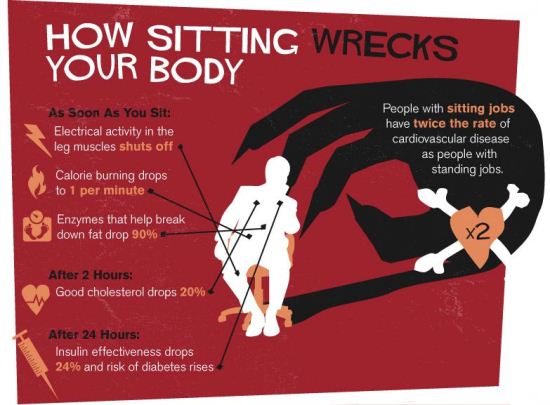They say sitting is the new smoking, and here’s why: The more time people spend sitting, the greater their risk of diabetes, cardiovascular events, and death, a new meta-analysis has shown.
This is the first research to systematically quantify the strength of association between sedentary behaviour – beyond just TV viewing – and health outcomes. It shows a particularly consistent relationship for diabetes, say Dr Emma G Wilmot (University of Leicester, UK) and colleagues in their paper in the November 2012 issue of Diabetologia.

Wilmot says that a number of important messages have emerged from the research. “People don’t think about sitting as being dangerous, and it’s quite a change, having to think, How can I reduce my sitting? rather than just How much exercise can I do? We’ve traditionally been focused on making sure we meet the physical-activity guidelines of 30 minutes per day, but with that approach we’ve overlooked what we do with the other 23 and a half hours in the day. If you sit for the rest of the day, that is going to have an impact on health, and that’s essentially what our meta-analysis shows.”
She stresses, however, that this does not mean that exercise is not important. “That’s obviously not the case. There’s a wealth of data showing that physical activity is important, but if people are spending a large percentage of their time sitting, they need to start thinking about how they can reduce this.”
There appear to be specific reasons why sitting too long can be particularly deleterious in terms of diabetes. “Sitting seems to have an immediate effect on how our bodies metabolize glucose. When we sit, our muscles are not used, and we quickly become more insulin resistant.” Studies have shown that people who sit after eating have 24% higher glucose levels than people who walk very slowly after a meal.
The opportunities for sedentary behaviour in modern society, such as watching television, sitting in a car, or using the computer, are ubiquitous,” they add, stating that estimates have put the time the average adult spends in sedentary pursuits at around 50% to 60% of their day.
For their review, the researchers searched for terms related to sedentary time and health outcomes. They combined the results of 18 studies including a total of 794 577 participants. The greatest sedentary time compared with the lowest was associated with a doubling of diabetes (relative risk 2.12), around a 2.5-fold increase in the risk of cardiovascular events, a 90% rise in risk of cardiovascular death and a 49% higher risk of all-cause mortality. Based on the pooled effects, all of these findings were significant.
Reference: Heartwire.
